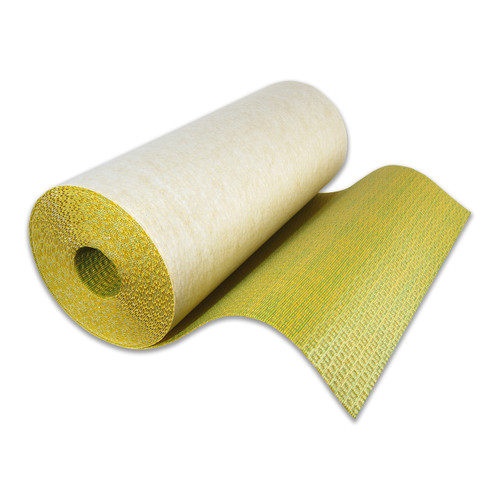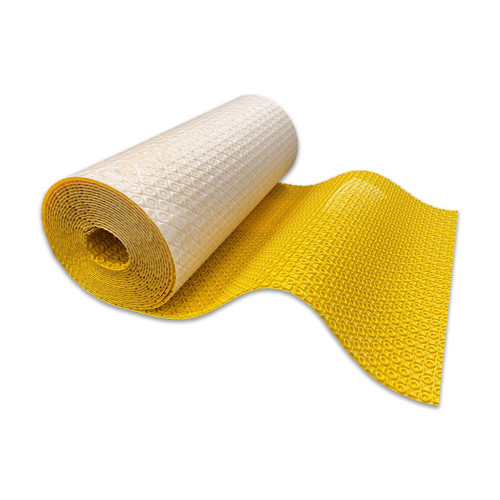
Genesis Strato Membrane Decoupling Matting - 30 sq./m
Genesis Strato Membrane Decoupling Matting - 30 sq./m
Strato membrane is a protective layer to avoid potential cracks and maintain a waterproof seal.
Strato membrane is a disconnecting solution that provides an unobtrusive protective layer to avoid potential cracks and maintain a waterproof seal. The HDPE dimpled membrane layer, with the roughened surface and a spunbonded polypropylene fabric, reduce tensions created by changes in the substrate to protect against cracks; suitable for both indoor and outdoor areas. The mat can be applied directly onto screed not requiring a 28 day curing period allowing for quick installations, and is designed with both Underfloor Heating and a variety of substrate applications in mind.
- Rolls out straight & flat with no waves
- Quick and easy installation
- Maximum protection for tiling
- Ideal for new build and renovation projects
- Protects tiling against cracking
- High shear elasticity
Specification
- Mat thickness: approx. 3mm
- Material: Plastic HDPE
- Weight: approx. 570 g/m²
- Roll width: 1m
- Roll length: 30m
System Advantage
- The system is easy and straightforward to install.
- Quick installation; for under-tile application it is a swift process shortening installation times as after laying the membrane no interruptions are necessary in the floor laying as it is not required to wait 28 days for the screed to harden.
- Lowers the probability of installation errors or damaging the materials by reducing the risk involved.
- The reduced thickness allows for an unobtrusive protective layer with essential features for renovations.
- The ceramic tile or stone cladding, both synthetic or natural, can be directly applied to the membrane using standard cementitious adhesive.
- The underlying substrate always remains protected and dry.
- Suitable for application across all-seasons, including winter.
Before laying Strato membrane, the substrate should be firm, sound, clean and under the recommended moisture content
Installing Strato membrane does not eliminate the need for expansion and perimeter joints, for which it is necessary to follow the instructions in the standard UNI 11493-1.
- Adhesive must be used to lay Strato membrane over the substrate, using a notched trowel.
- Strato membrane must be laid over the designated area, with the spunbonded cladded side facing down. Strato membrane must then be pressed down into adhesive with the aid of a float, applying pressure to prevent the creation of air pockets. Strato membrane must then be covered with another layer of class C2 (or greater) cementitious adhesive. The tiles can then be laid without waiting for it to dry, using a notched trowel of dimensions appropriate for the size of the tiles to be laid.
- Other measures are required during the laying stage to provide the additional waterproofing function. After laying Strato membrane , it is necessary to seal the joints between the adjacent sheets with adhesive, spreading it with the smooth side of the notched trowel.
- Then Strato band must be applied.
- The same procedure must be followed for the perimeter waterproofing, then adhesive is applied.
- Then Strato band must be laid. At the joint, Strato band must overlap it by at least 50 mm. The same procedure must be used for the perimeter joints, using Strato band centred in the floor / wall connection with adhesive. (For outdoor applications in particular, it is important to lay the cladding over the entire area, in compliance with the current reference standard 11493-1)
- Then the class C2 (or greater) cementitious adhesive must be spread followed by the laying of the finishing product
- The plinth/skirting board must be kept detached from the floor, the remaining gap must be sealed with elastic material (silicone or perimeter joint profile).
Substrate Preparation
Substrates must be prepared and pre-treated according to their type before laying Strato membrane as well as being
free of dust, dirt and anything that could cause separation. Outdoor substrates should have an incline of approximately 2%.
If special and countervailing requirements are needed for the substrate, this must be done before laying Strato membrane.
Laying of Strato membrane can be done on the following surfaces:
Screeds
a. Cement screed: The residual moisture content should be <2cm% and at least 28 days old.
b. Calcium sulphate (anhydrite) screed: Must be sanded, primed and fully prepared (according to the manufacturers
instructions) before laying Strato membrane; the residual moisture should not exceed 0.5cm%; recommended tile adhesive is hydraulically setting thin-bed adhesive (DIN EN 12004 C2).
c. Heating screed: Strato membrane can be used with UFH installed according to the manufacturers instruction and with all heating elements/conductors covered by adhesive.
d. Poured asphalt: must be sanded and prepared before installing Strato membrane ensure adhesive used has the adequate strength and flexibility required.
Concrete
Tiling can start as soon as the concrete base has reached the correct hardness level according to its class.
Resin and Coated Floorings
Make sure the floor can bear the weight of tiling and the correct adhesive is used to bond Strato membrane to the relevant coating/substrate
Chipboards and Pressed Sheets
Due to the effect of moisture on these substrates it is vital that they are waterproofed and protected from absorption.
Wooden Floors
Ensure that the floor is adequately secured and can bear the load of tiling. If the floor is unstable then it is recommended to use Plywood or Chipboard of an appropriate thickness to make the floor sound.




















